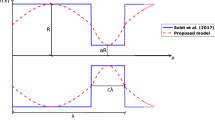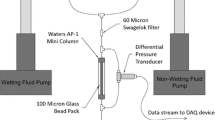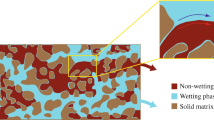Abstract
Subsurface two-phase flow in porous media often takes place in reservoirs with a high ratio between the associated lateral and vertical extent and the lateral and vertical flow time scales. This allows for a two-scale approach with effective quantities for two-dimensional horizontal flow equations obtained from reconstructed hydrostatic vertical pressure and saturation distributions. Here, we derive explicit expressions for the two dimensional constitutive relationships for a play-type hysteretic Brooks–Corey capillary pressure function with a pore-size distribution index of 2 and quadratic relative permeabilities. We obtain an explicit hysteretic parametrization for the upscaled capillary pressure function and the upscaled relative permeabilities. The size of the hysteresis loop depends on the ratio between buoyancy and the entry pressure, i.e. it scales with the reservoir height and the ratio between drainage and imbibition capillary pressure. We find that the scaling for the relative permeability is non-monotonic and hysteresis vanishes for both small and large reservoirs.










Similar content being viewed by others
Explore related subjects
Discover the latest articles and news from researchers in related subjects, suggested using machine learning.References
Bear, J.: Dynamics of Fluids in Porous Media. Dover Publications, New York (1972)
Beliaev, A.Y., Hassanizadeh, S.M.: A theoretical model of hysteresis and dynamic effects in the capillary relation for two-phase flow in porous media. Transport in Porous Media 43, 487–510 (2001)
Brooks, R.H., Corey, A.T.: Hydraulic properties of porous media. In: Hydrology Papers, vol. 3. Colorado State University, Fort Collins (1964)
Court, B., Bandilla, K.W., Celia, M.A. Janzen, A., Dobossy, M., Nordbotten, J.M.: Applicability of vertical-equilibrium and sharp-interface assumptions in \(CO_2\) sequestration modeling. Int J Greenh Gas Control 10, 134–147 (2012)
Cueto-Felgueroso, L., Juanes, R.: Nonlocal interface dynamics and pattern formation in gravity-driven unsaturated flow through porous media. Phys. Rev. Lett. 101(24), 244504. http://link.aps.org/abstract/PRL/v101/e244504 (2008). doi:10.1103/PhysRevLett.101.244504
Doster, F., Nordbotten, J., Celia, M.: Impact of capillary hysteresis and trapping on vertically integrated models for \(\text{ CO }_2\) storage. Adv Water Res 62, 465–474 (2013). doi:10.1016/j.advwatres.2013.09.005
Doster, F., Zegeling, P.A., Hilfer, R.: Numerical solutions of a generalized theory for macroscopic capillarity. Phys. Rev. E 81(3), 036307 (2010). doi:10.1103/PhysRevE.81.036307
Gasda, S.E., Nordbotten, J.M., Celia, M.A.: Vertical equilibrium with sub-scale analytical methods for geological (\(\text{ CO }_2\)) sequestration. Comput. Geosci. 13(4), 469–481 (2009). doi:10.1007/s10596-009-9138-x
Hassanizadeh, S., Celia, M.A., Dahle, H.: Dynamic effect in the capillary pressure-saturation relationship and its impacts unsaturated flow. Vadose Zone J. 1, 38–57 (2002)
Hesse, M., Tchelepi, H., Cantwell, B., Orr Jr, F.: Gravity currents in horizontal porous layers: transition from early to late self-similarity. J. Fluid Mech. 577, 363–383 (2007)
Joekar, V., Hassanizadeh, S.M., Leijnse, A.: Insights into the relationships among capillary pressure, saturation, interfacial area and relative permeability using pore-scale network modeling. Transp. Porous Media 74(2), 201219 (2008)
Juanes, R., MacMinn, C., Szulczewski, M.: The footprint of the \(\text{ CO }_2\) plume during carbon dioxide storage in saline aquifers: Storage efficiency for capillary trapping at the basin scale. Transp. Porous Media 82, 19–30 (2010). doi:10.1007/s11242-009-9420-3
Lake, L.W.: Enhanced Oil Recovery. Prentice Hall, New Jersey (1989)
Morrow, N.R., Harris, C.C.: Capillary equilibrium in porous materials. Soc. Pet. Eng. J. 5, 15–24 (1965)
Nordbotten, J., Celia, M.: Geological Storage of \(\text{ CO }_2\), Wiley (2012)
Nordbotten, J., Dahle, H.: Impact of Capillary Forces on Large-Scale Migration of \(\text{ CO }_2\). In: 18th Conference on Computational Methods for Water Resources. Barcelona, Spain. http://www.arks.princeton.edu/ark:/88435/dsp01pn89d657garks.princeton.edu/ark:/88435/dsp01f7623c57k (2010)
Nordbotten, J.M., Celia, M.A.: An improved analytical solution for interface upconing around a well. Water Resour. Res. 42, W08433 (2006). doi:10.1029/2005WR004738
Nordbotten, J.M., Celia, M.A.: Similarity solutions for fluid injection into confined aquifers. J. Fluid Mech. 561, 307–327 (2006). doi:10.1017/S0022112006000802
Nordbotten, J.M., Dahle, H.K.: Impact of the capillary fringe in vertically integrated models for \(\text{ CO }_2\) storage. Water Resour. Res. 47, W02537 (2011). doi:10.1029/2009WR008958
Yortsos, Y.C.: A theoretical analysis of vertical flow equilibrium. Transp. Porous Media 18, 107–129 (1995)
Author information
Authors and Affiliations
Corresponding author
Appendix
Appendix
1.1 Limits of capillary pressure relations for primary processes
For \(B\rightarrow 0\) the branch \(Z^{{\chi }}_1(S_w)\) is relevant. Hence, for the limit \(\lim _{B\rightarrow 0}P_c^{{\chi }}\) we write
where first the square root was approximated by its Taylor expansion and in the second approximation terms of order \(B\) and higher have been neglected.
For \(B\rightarrow \infty \) the branch \(Z^{{\chi }}_2(S_w)\) is relevant. Therefore we write for the limit \(\lim _{B\rightarrow \infty }P_c^{{\chi }}\)
where the square root was approximated by its Taylor expansion. From Eq. (81) we immediately obtain the limit of the difference between drainage and imbibition as
1.2 Explicit expressions for secondary processes
Explicit analytic expressions for the relationship between coarse scale saturations and the position of vanishing fine-scale capillary pressure are given.
1.2.1 Drainage followed by an imbibition
The three functions for the position of the vanishing capillary pressure for a drainage followed by an imbibition are given by
and
and
In Eqs. (83) and (84) the argument of \(Z^{d}_1=Z^{d}_1({S^t})\) and in Eq. (85) the argument of \(Z^{d}_2=Z^{d}_2({S^t})\) have been omitted to improve the readability.
1.2.2 Imbibition followed by a drainage
The three functions for the position of the vanishing capillary pressure for an imbibition followed by a drainage are given by
and
and
In Eq. (86) the argument of \(Z^{i}_1=Z^{i}_1({S^t})\) and in Eqs. (87) and (88) the argument of \(Z^{i}_2=Z^{i}_2({S^t})\) have been omitted to improve the readability.
Rights and permissions
About this article
Cite this article
Doster, F., Nordbotten, J.M. & Celia, M.A. Hysteretic upscaled constitutive relationships for vertically integrated porous media flow. Comput. Visual Sci. 15, 147–161 (2012). https://doi.org/10.1007/s00791-013-0206-3
Received:
Accepted:
Published:
Issue Date:
DOI: https://doi.org/10.1007/s00791-013-0206-3




